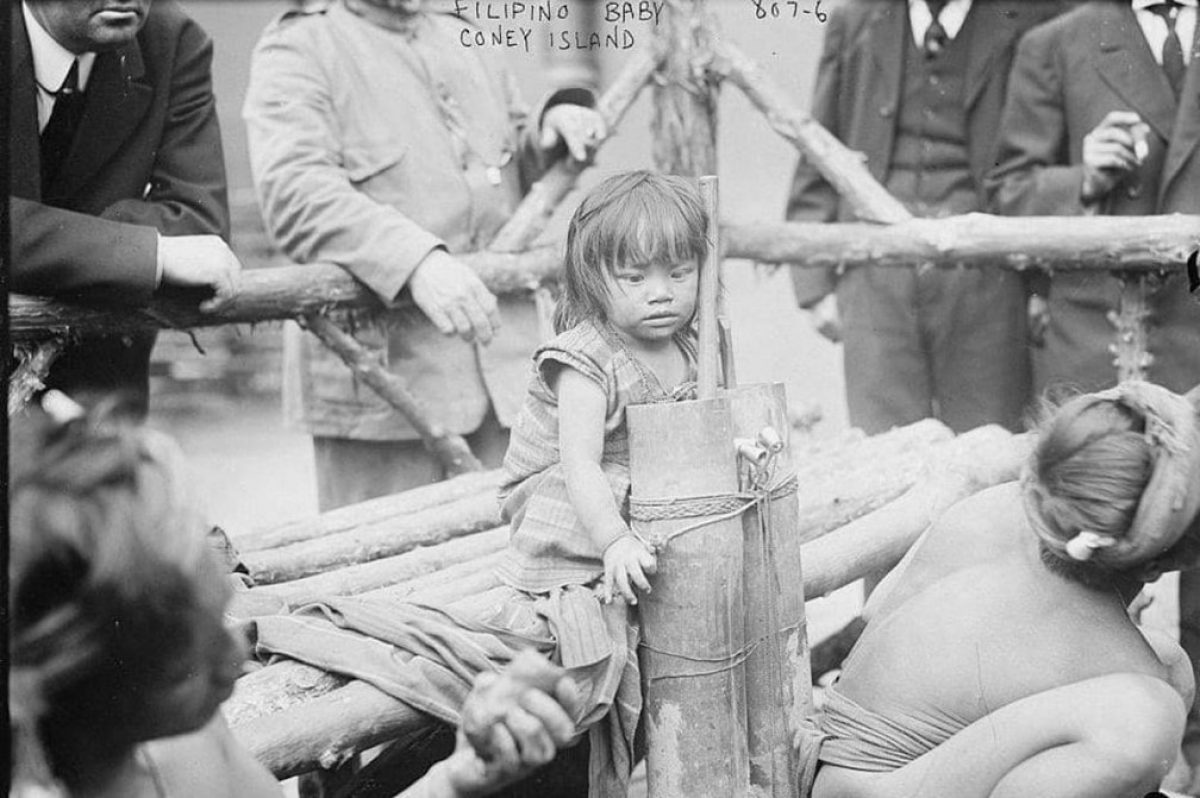Below is the 1898 Treaty of Paris whereby Spain ceded the Philippines along with Puerto Rico and Guam for $20 million ending the Spanish-American War of 1898. The Treaty was ratified by the 55th U.S. Congress on Feb. 6, 1899 by a vote of 57 to 27, just over the two-thirds majority required.
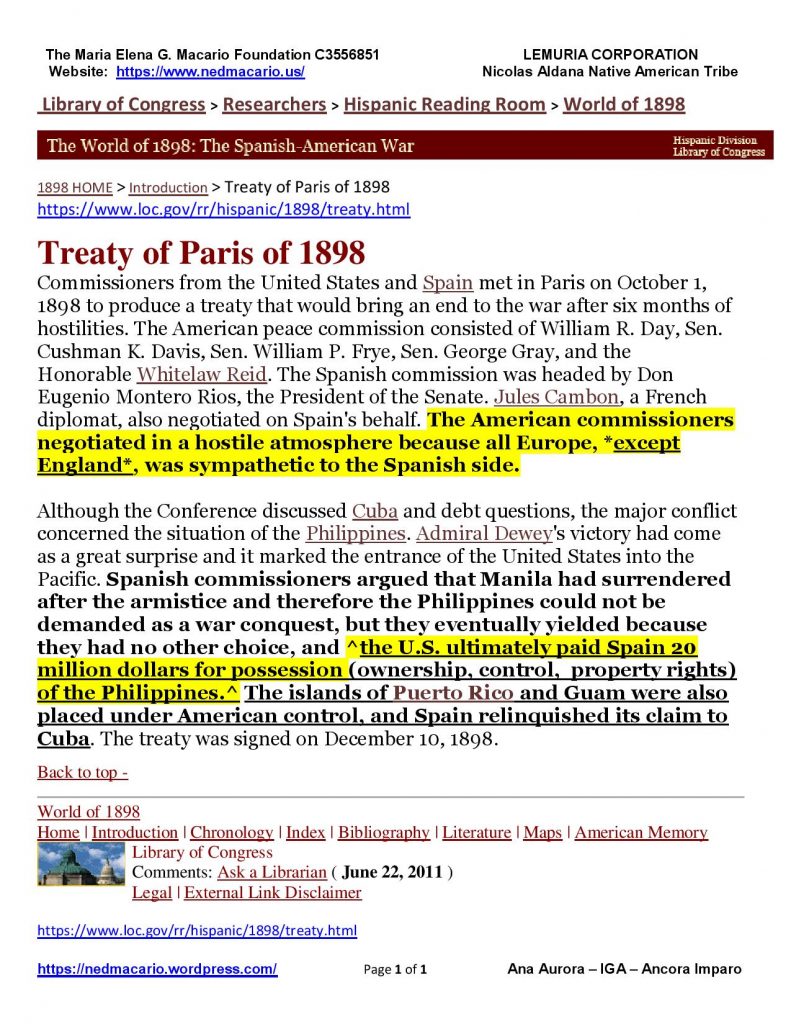
Six (6) days after the 1898 Treaty of Paris was ratified by the U.S. Congress, the German–Spanish Treaty of 1899 was signed on Feb. 12, 1899, The treaty between the German Empire and the Kingdom of Spain, was the sale of Spain’s vast majority of its remaining Pacific Ocean islands to Germany for 25 million pesetas (equivalent to 17 million Marks).
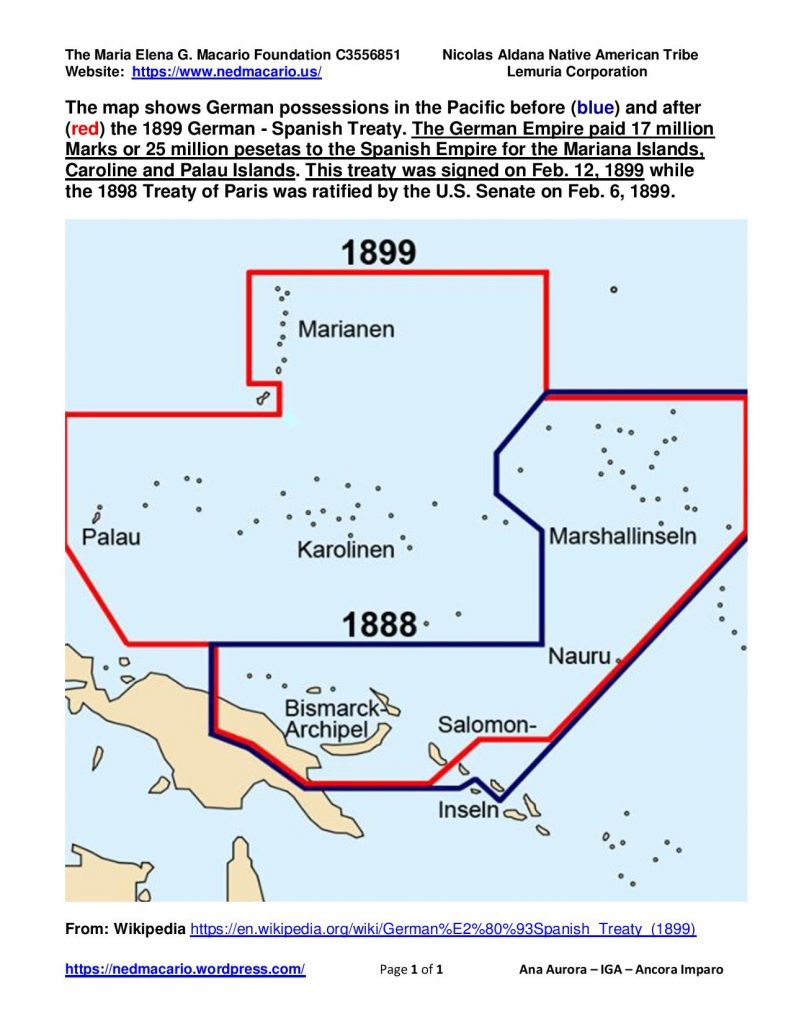
The First Abandonment of the Philippine Territory March 24, 1934
By 1933, the U.S.A. was in the Great Depression. The Democrat-dominated 72nd Congress failed to get rid of the Philippine territory. It was the 73rd Congress that denied the territorial legislature the right to reject and veto the bill. The Tydings-McDuffie Act no longer required the approval of the legislature in the Philippines or the approval and consent of the Filipino people.
The Tydings-McDuffie Act or the Philippine Independence Act of 1934, passed without the approval or input from the Filipino people or the territorial legislature has rendered the same null and void from the very beginning. Please see: The Legal Effect of the Acquisition of the Philippine Islands, University of Pennsylvania, April 1900
FDR promised to grant independence to the Philippines (read: abandon the Philippine territory) at the HEIGHT OF THE GREAT DEPRESSION.
We’ve come full circle because the fastest way to save the American economy from the COVID19 PANDEMIC is to reacquire U.S. sovereignty over the Philippines under the protection and dominion of HM Queen Elizabeth II and transfer factories from China & elsewhere making products of those factories MADE IN THE USA!
Wednesday April 29, 2020
US GDP shrank 4.8% in the first quarter amid biggest contraction since the 2008 financial crisis
PUBLISHED WED, APR 29 2020 at 8:33 AM EDTUPDATED 4 HOURS AGO
- GDP in the first quarter contracted 4.8%, compared to estimates of a 3.5% drop, the Bureau of Economic Analysis reported Wednesday.
- This was the first negative reading since the first quarter of 2014, though not as bad as the worst of the financial crisis.
- Economists expect the Q1 reading to decline even more when the final revisions are issued.
Gross domestic product fell 4.8% in the first quarter, according to government numbers released Wednesday that provide the first detailed glimpse into the deep damage the coronavirus wreaked on the U.S. economy.
Economist surveyed by Dow Jones had expected the first estimate of GDP to show a 3.5% contraction.
This marked the first negative GDP reading since the 1.1% decline in the first quarter of 2014 and the lowest level since the 8.4% plunge in Q4 of 2008 during the worst of the financial crisis.
The biggest drags on the economy were consumer spending, nonresidential fixed investment, exports and inventories. Residential fixed investment, which jumped 21%, along with spending from both the federal and state governments helped offset some of the damage. Federal spending was up 1.7%.
Consumer expenditures, which comprise 67% of total GDP, plunged 7.6% in the quarter as all nonessential stores were closed and the cornerstone of the U.S. economy was taken almost completely out of commission. Durable goods spending tumbled 16.1% while expenditures on services were down 10.2%.
Exports dropped 8.7% while imports fell 15.3%, including a 30% drop in services.
The count of all goods and services produced in the U.S. shows that even though the first quarter saw only two weeks of shutdown, the impact was pronounced and set the stage for a second-quarter picture will be the worst in the post-World War II era.
Goods consumption fell 1.3% while services slumped 10.2%.
“The upshot is this was already an economic catastrophe within two weeks of the lockdowns going into effect,” said Paul Ashworth, chief U.S. economist at Capital Economics. “The second quarter will be far worse.”
Markets, however, showed little reaction to the numbers. Instead, Wall Street focused on positive news from Gilead, which reported that testing on its coronavirus treatment drug remdesivir showed positive results. The Dow opened higher by about 400 points.
“The markets are going to very much look through the first-quarter GDP data,” said Katie Nixon, chief investment officer at Northern Trust Wealth Management. “We know it’s bad. The magnitude is almost irrelevant now as we’re looking at a much steeper decline in second-quarter activity.”
Trouble ahead
Most economists see the U.S. in recession already even though the technical definition is generally two consecutive quarters of negative growth. The fourth quarter of 2019 saw GDP rise 2.1%.
That view is largely because the first-quarter numbers only include a few weeks of the economic shutdown brought about by the coronavirus, and even at that probably underestimate the real damage.
The Bureau of Economic Analysis itself pointed out in a technical note that the initial reading was probably inaccurate.
The coronavirus lockdown “led to rapid changes in demand, as businesses and schools switched to remote work or canceled operations, and consumers canceled, restricted, or redirected their spending. The full economic effects of the COVID-19 pandemic cannot be quantified in the GDP estimate for the first quarter of 2020 because the impacts are generally embedded in source data and cannot be separately identified,” the bureau said in a statement.
When the Commerce Department makes its revisions to the initial GDP reading, the result could show a decline of about 3 to 4 percentage points for a total slide of 8.25%, according to a Goldman Sachs estimate.
During the financial crisis, for instance, the first estimate for Q4 2008 was a drop of 3.8%, which more than doubled by the time the government went through all the numbers. One issue is that with most businesses closed – Citigroup estimates 95% of GDP is under stay-at-home orders – it was difficult to get accurate numbers on the movement of goods and services.
“We believe economic reality during the quarter was even worse,” Goldman economist Spencer Hill said in a note. “Larger than usual revisions to growth data are common in recessions and other periods of high economic volatility.”
Specifically, retail sales and durable goods orders for March that weren’t as bad as feared also could indicate some issues with data gathering.
“Reflecting the onset of recession in the US and the scope for additional economic measurement challenges unique to the coronavirus, we believe the wedge between growth data and economic reality is large and rising,” Hill wrote.
The Second Abandonment of the Philippines was on July 4, 1946 when US Army Brig. Gen. Manuel A. Roxas sought independence to avoid facing the court martial for treason after collaborating with Japanese during the occupation of the Philippines in WWII. Manuel Roxas became the Commonwealth President and later the president of the so-called republic of the Philippines founded on lies, treason and dishonor. Being relatives of Ayala, Zobel, Soriano, Araneta and province mate of the Lopezes, Roxas and the oligarch-traitors pocketed every penny of war reparations the U.S. and Japan gave after WWII. They then used U.S. taxpayers’ money to start amassing their ill-gotten wealth. This is where they started: Ayala Triangle Is In Fact the Nielson Airfield in WWII
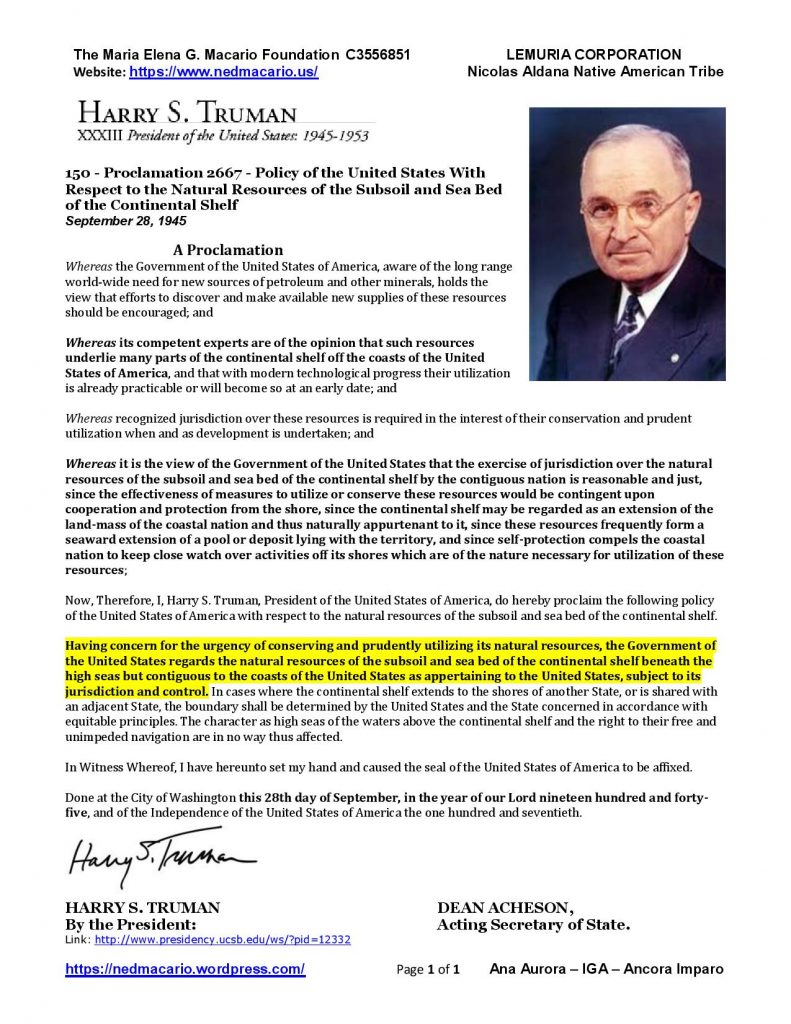
Below is the map of the Philippines applying the 200-mile Exclusive Economic Zone (EEZ) per Pres. Truman’s Proclamation 2667 signed on Sept. 28, 1945 at which time the USA has sovereignty and jurisdiction over the Philippine Islands, a U.S. territory.
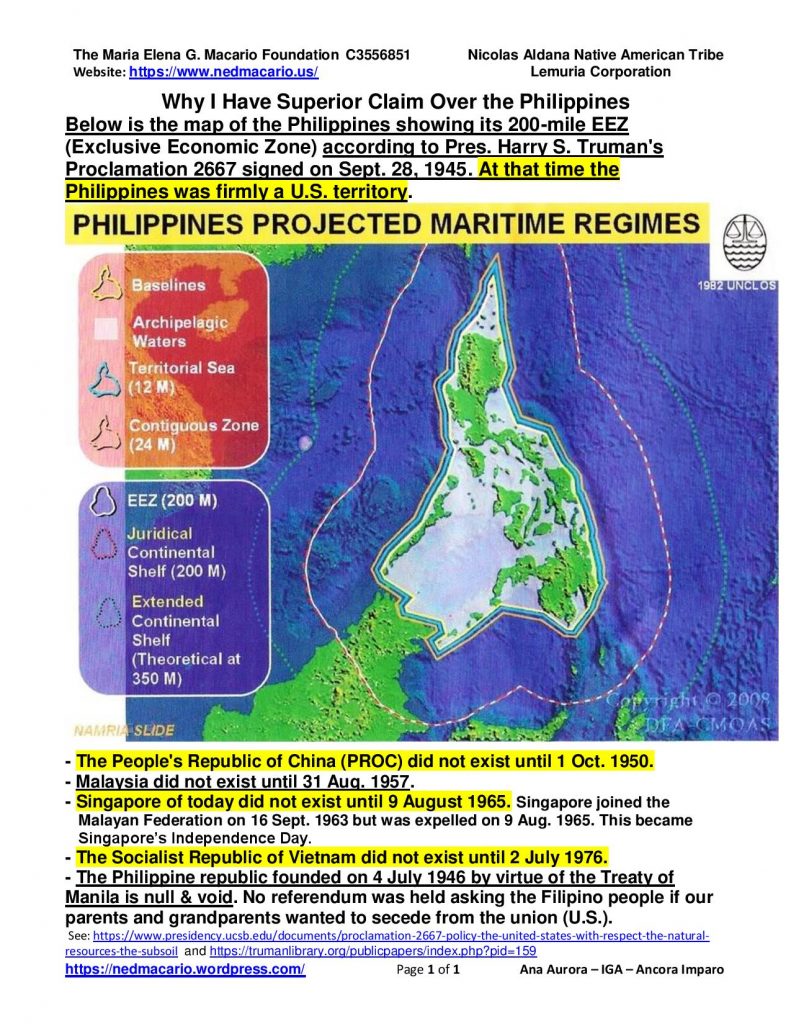
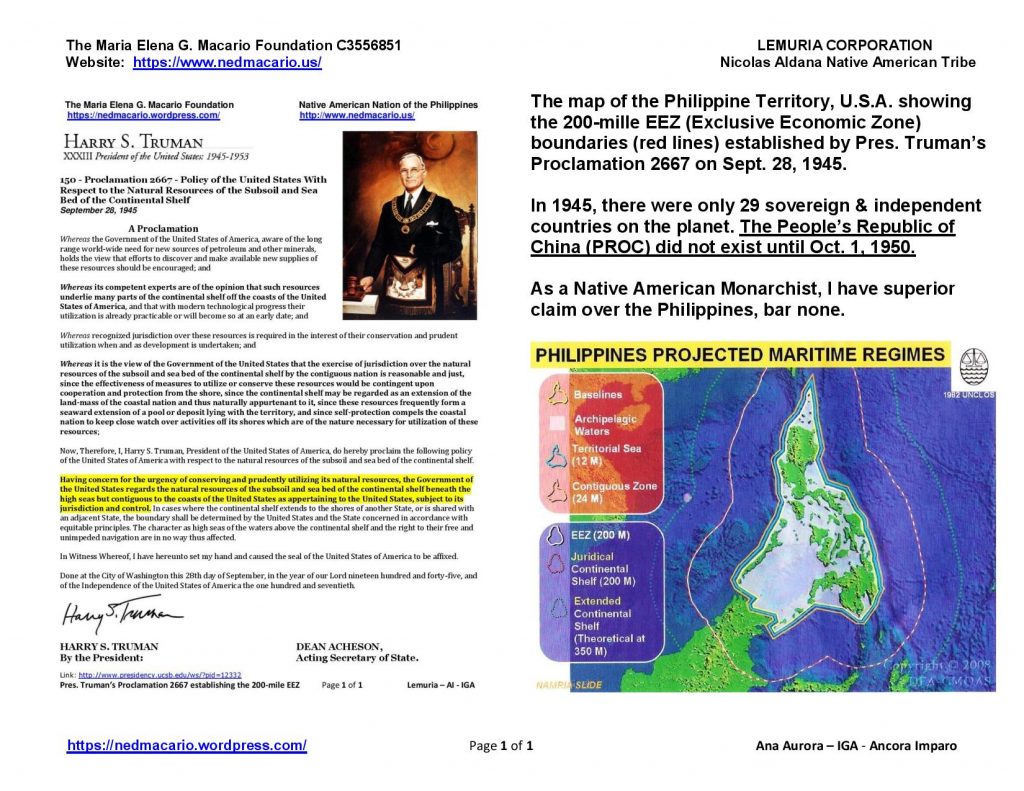
Then on April 28, 2014, Pres. Obama and Benigno Aquino III held a joint press conference in Malacanan Palace. In answer to the first question, Pres. Obama categorically stated: At 14:20 – “There are a whole range of issues on the international stage in which cooperation between the U.S. and China are vital. SO OUR GOAL IS NOT TO COUNTER CHINA. Our GOAL is NOT to CONTAIN CHINA.“
At 14:34 – *“WE DO NOT HAVE CLAIMS IN THIS AREA, TERRITORIALLY.“* We’re an Asia Pacific nation and our primary interest is the peaceful resolution of conflict, the freedom of navigation that allows for continued progress and prosperity. And we don’t even take a specific position on the disputes between nations. “
In another question, Pres. Obama made it perfectly clear the priority of the USA: At 25:32 PRESIDENT OBAMA: “Well, let me repeat what I said earlier. I think that IT IS GOOD FOR THE REGION and GOOD FOR THE WORLD IF CHINA IS SUCCESSFULLY DEVELOPING, IF CHINA IS LIFTING MORE OF ITS PEOPLE OUT OF POVERTY. There are a lot of people in China, and the more they’re able to develop and provide basic needs for their people and work cooperatively with other countries in the region, that’s only going to strengthen the region — that’s not going to weaken it.
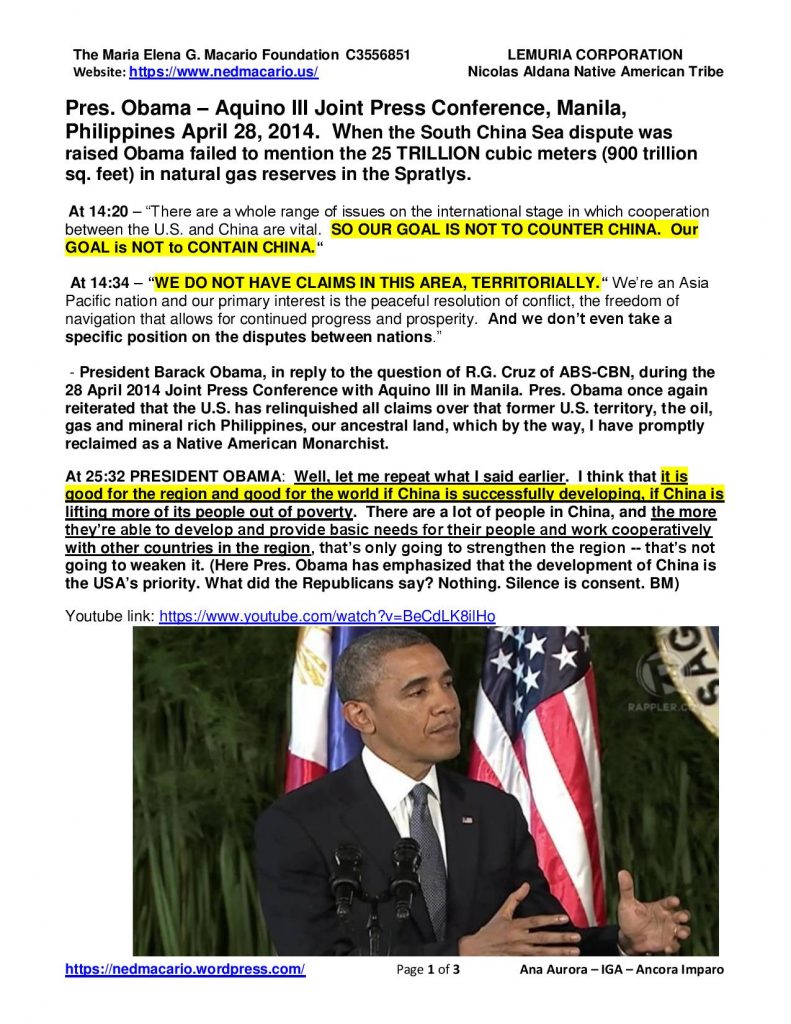
At 25:32 *PRESIDENT OBAMA*: “Well, let me repeat what I said earlier. *I think that IT IS GOOD FOR THE REGION and GOOD FOR THE WORLD IF CHINA IS SUCCESSFULLY DEVELOPING, IF CHINA IS LIFTING MORE OF ITS PEOPLE OUT OF POVERTY.*”
Listen to Pres. Obama himself:
*PRESIDENT OBAMA: Well, I’ve been consistent throughout my travels in Asia.*
At 14:20 – *“There are a whole range of issues on the international stage in which cooperation between the U.S. and China are vital. SO OUR GOAL IS NOT TO COUNTER CHINA. Our GOAL is NOT to CONTAIN CHINA.“*
=======
*PRESIDENT OBAMA: Well, I’ve been consistent throughout my travels in Asia.*
At 14:20 – *“There are a whole range of issues on the international stage in which cooperation between the U.S. and China are vital. SO OUR GOAL IS NOT TO COUNTER CHINA. Our GOAL is NOT to CONTAIN CHINA.“*
At 14:34 – *“WE DO NOT HAVE CLAIMS IN THIS AREA, TERRITORIALLY.“* We’re an Asia Pacific nation and our primary interest is the peaceful resolution of conflict, the freedom of navigation that allows for continued progress and prosperity. And we don’t even take a specific position on the disputes between nations.
Q: Good afternoon, Your Excellencies. This question goes to President Obama, but I would also like to hear the thoughts of President Aquino. I understand the tough balancing act that you need to do between China and your allies in Asia. But do you believe that China’s expansionism is a threat to regional peace and stability? And will the Mutual Defense Treaty apply in the event that the territorial conflict with China escalates into an armed conflict?
At 25:32 *PRESIDENT OBAMA*: Well, let me repeat what I said earlier. *I think that IT IS GOOD FOR THE REGION and GOOD FOR THE WORLD IF CHINA IS SUCCESSFULLY DEVELOPING, IF CHINA IS LIFTING MORE OF ITS PEOPLE OUT OF POVERTY.* There are a lot of people in China, and the more they’re able to develop and provide basic needs for their people and work cooperatively with other countries in the region, that’s only going to strengthen the region — that’s not going to weaken it.
*[*[Under a Democrat administration and Democrat-controlled Congress, WASHINGTON DC’s PRIORITY IS THE DEVELOPMENT OF THE PEOPLE‘S REPUBLIC OF CHINA at the expense of the Philippines, a former US territory and everyone else.]*
What was the reaction of the Republicans (GOP) who dominated the US Congress at that time ?
*A deafening SILENCE. And silence is consent*. – BM
*This is why for my ancestral land, the oil, gas and mineral-rich Philippines, I, as a Native American Monarchist with dual nationality, prefer a Freely Associated State with the UK & the USA under the PERSONAL protection and dominion of HM Queen Elizabeth II and with a Royal Charter we shall, among others, recover and administer our ancestral land.*
Aquino, Obama joint press conference April 28, 2014 in Malcanang Palace, Manila, Philippines
8,717 views•Apr 28, 2014
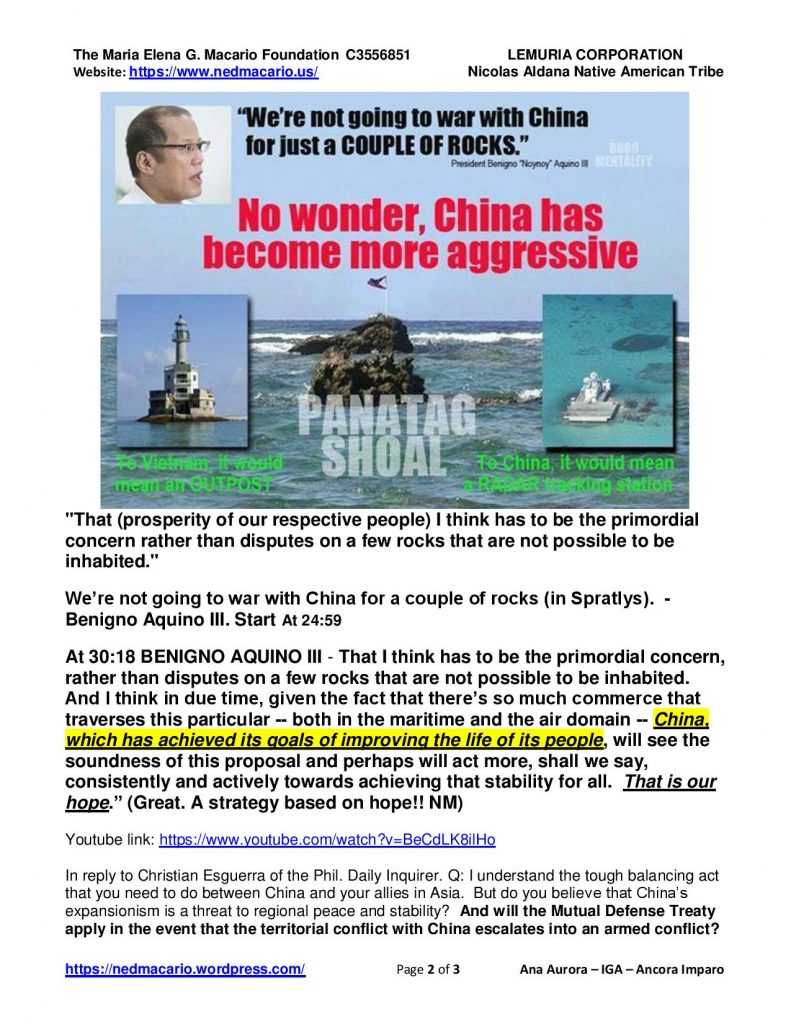
In the meantime while Pres. Obama and Benigno Aquino III were conducting the joint conference, the Chinese were busy reclaiming, building and militarizing the reefs, atolls, shoals and islets in the Spratlys.
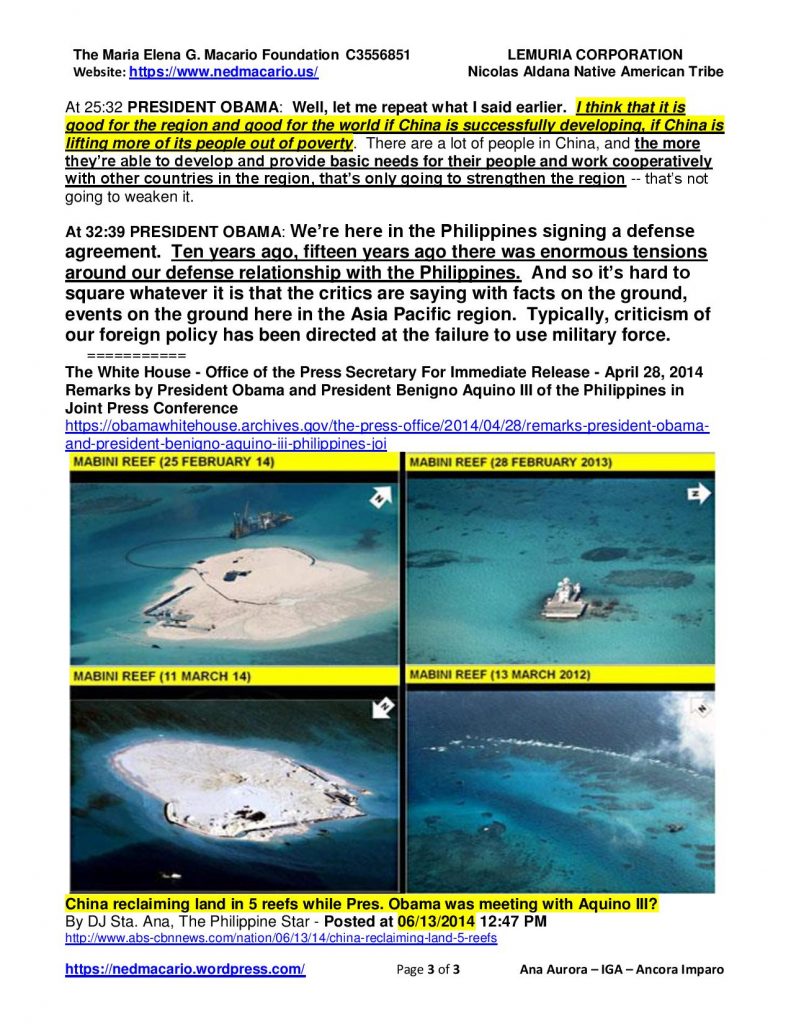
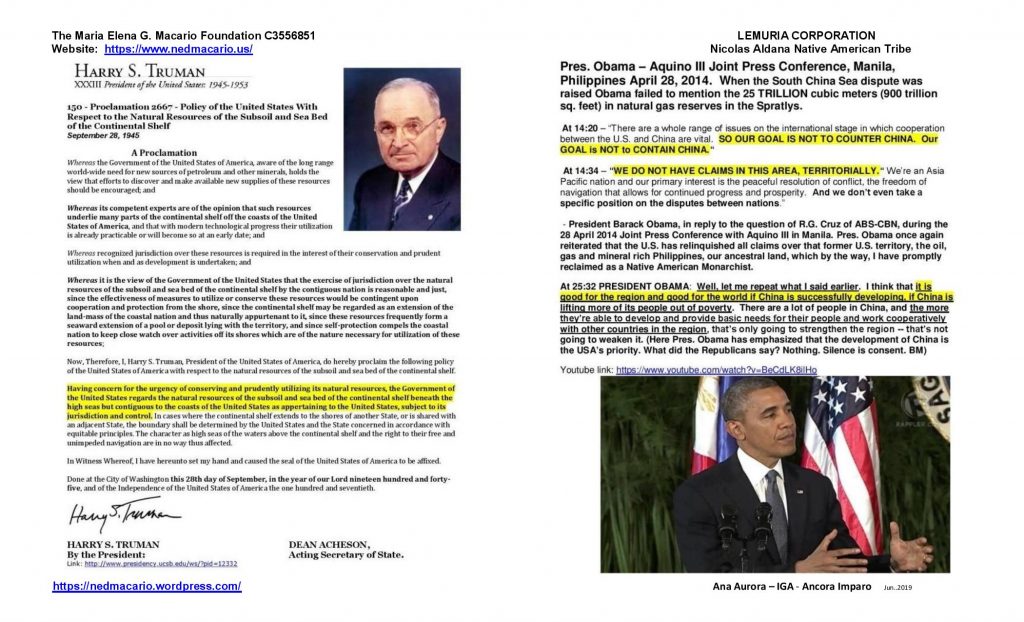
This photo proves that there’s a huge crisis in education in the USA and the Philippines because of the manipulation by the Orwellian Mainstream Media in the USA.
=======
Above Left: Pres. Truman’s Proclamation 2667 on Sept. 28, 1945 declared the 200-mile EEZ which included the Philippines, then an integral part of the U.S.A. until July 4, 1946 when the Philippines was granted independence the Filipino people never wanted or were consulted about. Our parents and grandparents were stripped of their US nationality without due process, forced to secede from the USA and become citizens of a “republic” controlled by traitors who served the Japanese during WWII.
Links: https://www.trumanlibrary.gov/library/public-papers/150/proclamation-2667-policy-united-states-respect-natural-resources-subsoil
Above Right: In answer to a question during the joint press conference with Aquino III in Manila, Philippines on April 28, 2014 Barack Obama categorically stated that the U.S.A. does not have any territorial claims in the region, officially giving up all U.S. territorial claims over the Philippines, a former U.S. territory which I promptly claimed on behalf of HM Queen Elizabeth II.
I think that IT IS GOOD FOR THE REGION and GOOD FOR THE WORLD IF CHINA IS SUCCESSFULLY DEVELOPING, IF CHINA IS LIFTING MORE OF ITS PEOPLE OUT OF POVERTY.
======
Obama: The first false flag president of the USA, the real “Manchurian Candidate”
Obama – Aquino III Joint Press Conference April 28. 2014
https://obamawhitehouse.archives.gov/the-press-office/2014/04/28/remarks-president-obama-and-president-benigno-aquino-iii-philippines-joi
The solution is to form the Freely Associated State of the Philippines under the protection and dominion of HM Queen Elizabeth II 🇬🇧 . Then we’ll explore joint sovereignty over the Philippines with the USA 🇺🇸 , a secular country where civilian authority is above the military and the state is superior to religion.
Even Pres. Trump to this day is SILENT when it comes to Pres, Obama’s FINAL abandonment of the Philippines on April 28, 2014.
Excerpts from the Obama-Aquino III joint press conference
PRESIDENT OBAMA: Well, I’ve been consistent throughout my travels in Asia.
At 14:20 – “There are a whole range of issues on the international stage in which cooperation between the U.S. and China are vital. SO OUR GOAL IS NOT TO COUNTER CHINA. Our GOAL is NOT to CONTAIN CHINA.“
